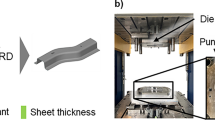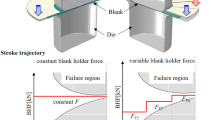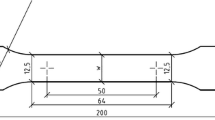Abstract
The deep drawing process, one of the sheet metal forming methods, is very useful in the industrial field because of its efficiency. The limiting drawing ratio (LDR) is affected by many material and process parameters, such as the strain-hardening exponent, the plastic strain ratio, friction and lubrication, the blank holder force, the presence of drawbeads, the profile radius of the die and punch, etc. In order to verify the finite element method (FEM) simulation results of the LDR, the experimental data are compared with the results of the current simulation. The influences of the process parameters such as the blank holder force, the profile radius of the die, the clearance between the punch and the die, and the friction coefficient on the LDR are also examined. The abductive network was then applied to synthesize the data sets obtained from the numerical simulation. The predicted results of the LDR from the prediction model are in good agreement with the results obtained from the FEM simulation. By employing the predictive model, it can provide valuable references to the prediction of the LDR under a suitable range of process parameters.
Similar content being viewed by others
References
Woo DM (1965) The stretching forming test. Eng 200:876–880
Odell EI, Clausen WE (1977) Numerical solution of a deep-drawing problem. ASME J Eng Ind 99:206–209
Korhonen AS (1982) Drawing force in deep drawing of cylindrical cup with flat-nosed punch. J Eng Ind 104(1):29–37
Kobayashi S, Oh S-I, Altan T (1989) Metal forming and the finite element method. Oxford University Press, Oxford, UK
Hrivnak A, Sobotova L (1992) Influence of the deformational ageing and the conditions of stress on the properties of the deep-drawing steel sheet. J Mater Process Technol 34(1–4):425–430
Date PP, Padmanabhan KA (1992) On the prediction of the forming-limit diagram of sheet metals. Int J Mech Sci 34(5):363–374
Yossifon S, Tirosh J (1991) On the dimensional accuracy of deep drawing products by hydroforming processes. Int J Mech Sci 33(4):279–295
Huang Y-M, Chen J-W (1995) Influence of the die arc on formability in cylindrical cup-drawing. J Mater Process Tech 55(3–4):360–369
Huang Y-M, Cheng J-W (1997) Influence of lubricant on limitation of formability of cylindrical cup-drawing process. J Mater Process Tech 63(1–3):77–82
Moshksar MM, Zamanian A (1997) Optimization of the tool geometry in the deep drawing of aluminium. J Mater Process Tech 72(3):363–370
Yang TS, Hsu YC (2006) An analysis of the hemisphere deep drawing process of metal sheet. J Chi Soc Mech Eng 27(1):81–86
Woo DM (1968) On the complete solution of the deep-drawing problem. Int J Mech Sci 10:83–87
Lin JC (2002) Prediction of rolling force and deformation in three-dimensional cold rolling by using the finite-element method and a neural network. Int J Adv Manuf Technol 20(11):799–806
Lin FC, Lin SY (2002) Radius ratio estimation and fold situation prediction of the deformation profile in forging-extrusion process. Comput Struct 80(24):1817–1826
Lin SY, Lin FC (2003) Prediction of fold defect in barreling formations of cylinder upsetting. Finite Elem Anal Des 39(4):325–341
Lin FC, Kwan CT (2004) Application of abductive network and FEM to predict an acceptable product on T-shape tube hydroforming process. Comput Struct 82(15–16):1189–1200
Scientific Forming Technologies (2003) DEFORM-2D user’s manual, version 8.0. Scientific Forming Technologies Corporation, Columbus, Ohio
Ivakhnenko AG (1971) Polynomial theory of complex systems. IEEE Trans Syst 1(4):364–378
Patrikar A, Provence J (1996) Nonlinear system identification and adaptive control using polynomial networks. Math Comput Modeling 23(1–2):159–173
Barron AR (1984) Predicted square error: a criterion for automatic model selection. In: Farlow SJ (ed) Self-organizing methods in modeling: GMDH type algorithms. Marcel Dekker, New York
Author information
Authors and Affiliations
Corresponding author
Rights and permissions
About this article
Cite this article
Yang, TS. The application of abductive networks and FEM to predict the limiting drawing ratio in sheet metal forming processes. Int J Adv Manuf Technol 37, 58–69 (2008). https://doi.org/10.1007/s00170-007-0949-4
Received:
Accepted:
Published:
Issue Date:
DOI: https://doi.org/10.1007/s00170-007-0949-4




